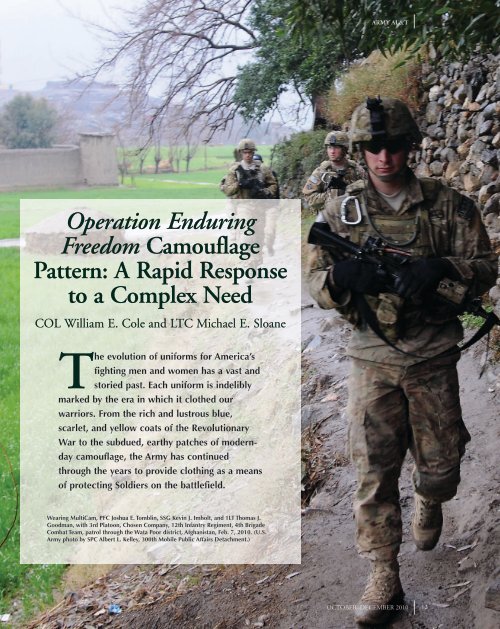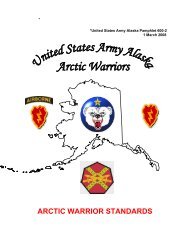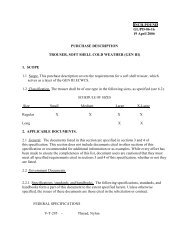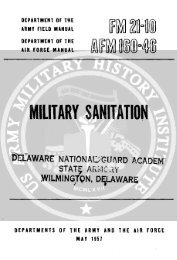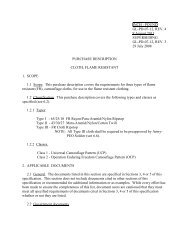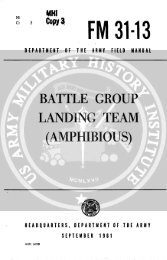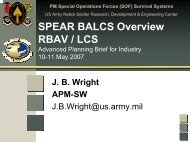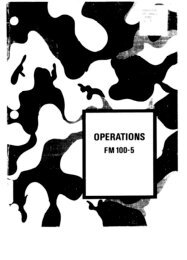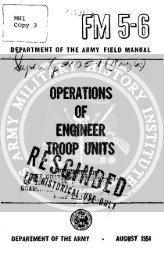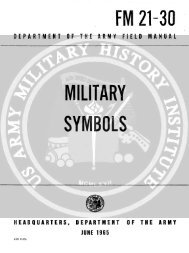Phase I (Immediate Action) - CIE Hub
Phase I (Immediate Action) - CIE Hub
Phase I (Immediate Action) - CIE Hub
Create successful ePaper yourself
Turn your PDF publications into a flip-book with our unique Google optimized e-Paper software.
ARMY AL&T<br />
Operation Enduring<br />
Freedom Camouflage<br />
Pattern: A Rapid Response<br />
to a Complex Need<br />
COL William E. Cole and LTC Michael E. Sloane<br />
The evolution of uniforms for America’s<br />
fighting men and women has a vast and<br />
storied past. Each uniform is indelibly<br />
marked by the era in which it clothed our<br />
warriors. From the rich and lustrous blue,<br />
scarlet, and yellow coats of the Revolutionary<br />
War to the subdued, earthy patches of modernday<br />
camouflage, the Army has continued<br />
through the years to provide clothing as a means<br />
of protecting Soldiers on the battlefield.<br />
Wearing MultiCam, PFC Joshua E. Tomblin, SSG Kevin J. Imholt, and 1LT Thomas J.<br />
Goodman, with 3rd Platoon, Chosen Company, 12th Infantry Regiment, 4th Brigade<br />
Combat Team, patrol through the Wata Poor district, Afghanistan, Feb. 7, 2010. (U.S.<br />
Army photo by SPC Albert L. Kelley, 300th Mobile Public Affairs Detachment.)<br />
OCTOBER –DECEMBER 2010<br />
12
ARMY AL&T<br />
Woven deep into the history of our<br />
warfighting uniforms is Army acquisition,<br />
which over the past 50 years has<br />
been steadfast in enabling the most<br />
effective equipping of the Nation’s<br />
forces while maintaining an internal<br />
culture of constant organizational<br />
improvement. The Army acquisition<br />
system has successfully developed<br />
and rapidly fielded state-of-the-art<br />
improvements in Soldier uniforms and<br />
equipment, most recently under the<br />
auspices of Program Executive Office<br />
(PEO) Soldier.<br />
Now another chapter in the history<br />
of uniforms is being written with the<br />
introduction of a new uniform for U.S.<br />
forces fighting in Operation Enduring<br />
Freedom (OEF ). On Sept. 16, 2009,<br />
the Army unveiled a 4-phase plan to<br />
evaluate and decide which camouflage<br />
pattern or patterns would best serve the<br />
concealment needs of Soldiers serving<br />
in OEF. Ten and a half months later,<br />
the Army fielded the first unit with a<br />
suite of uniforms and accessories in the<br />
new OEF Camouflage Pattern (OCP),<br />
in a rapid yet rigorous process of study,<br />
analysis, planning, and procurement.<br />
This expedited but well-researched<br />
action to purchase and field Fire<br />
Resistant Army Combat Uniforms<br />
(FR ACUs) and associated equipment<br />
in a new camouflage pattern grew out<br />
of the Army’s continuing commitment<br />
to provide Soldiers with the equipment<br />
they need to be as lethal and survivable<br />
as possible in any operating environment.<br />
Effective concealment has been<br />
of particular concern in Afghanistan, with<br />
its diverse environments of mountains,<br />
woodland, and high desert. In OEF,<br />
Soldiers often travel through multiple<br />
environments in a single mission.<br />
The 4-phase plan included both immediate<br />
action, to provide concealment<br />
capability to two battalion-size elements<br />
in OEF, and a deliberate, thorough<br />
evaluation of camouflage alternatives<br />
for Soldiers in all regions and terrain<br />
types of Afghanistan. The end result<br />
was that in late July 2010, the Army<br />
began providing Soldiers in OEF with a<br />
camouflage pattern specifically chosen<br />
for the multiple operating environments<br />
of Afghanistan. The fielding<br />
began with a small headquarters detachment<br />
preparing to deploy to OEF and<br />
ramped up in August with two deploying<br />
brigade-size elements. In December<br />
2010, fielding will move to Soldiers<br />
who are deployed to OEF with more<br />
than 120 days remaining in theater.<br />
The fielding of uniforms and equipment<br />
in the OCP, known commercially<br />
as MultiCam, involves providing 23<br />
different uniform and equipment<br />
items, including body armor, rucksacks,<br />
helmet covers, and even knee and<br />
elbow pads, for about 10,200 Soldiers<br />
in FY10 and an anticipated 74,500<br />
Soldiers in FY11, not including spares<br />
and sustainment quantities. The cost is<br />
approximately $174 per uniform, with<br />
a basis of issue of four per Soldier, plus<br />
an estimated $4,208 per Soldier for<br />
associated equipment.<br />
A process that ordinarily would take at<br />
least 12 months—to develop, purchase,<br />
and field one item—was compressed<br />
into less than 8 months for an entire<br />
suite of items, so that the Army could<br />
be responsive to what Soldiers saw as a<br />
pressing need, and also be responsible<br />
for the science underpinning the decision<br />
and its fiscal impacts.<br />
<strong>Phase</strong> I (<strong>Immediate</strong> <strong>Action</strong>)<br />
In fall 2009, two battalion-size units<br />
serving in OEF received the FR ACU<br />
in a pattern other than the standard<br />
Universal Camouflage Pattern (UCP)<br />
that was chosen when the ACU was<br />
introduced in June 2004. They also<br />
received Organizational Clothing and<br />
Individual Equipment (O<strong>CIE</strong>) that<br />
blended with each pattern.<br />
One unit (2nd Battalion, 12th Infantry<br />
Regiment) received uniforms and<br />
O<strong>CIE</strong> in the MultiCam pattern, while<br />
the other (3rd Squadron, 61st Cavalry<br />
Regiment) received uniforms in UCP-<br />
Delta (UCP-D), a variant of UCP that<br />
adds the Coyote Tan color and uses less<br />
of the lighter sand and gray colors than<br />
in the UCP.<br />
These uniforms in alternate camouflage<br />
patterns were in addition to the<br />
Soldiers’ standard-issue FR ACUs in<br />
UCP. Unit commanders were responsible<br />
for deciding which uniform would<br />
be best suited to a given mission.<br />
Members of the Army’s camouflage assessment team wear the six different camouflage patterns they evaluated.<br />
From left, the patterns are: AOR-2, UCP, MultiCam, Desert Brush, UCP-Delta, and Mirage. The photo<br />
was taken in Khost province, Afghanistan, close to the Pakistan border, in late October 2009. (Photo courtesy<br />
of Naval Research Laboratory, PEO Soldier, and NSRDEC.)<br />
The Soldiers in the two battalions<br />
would provide essential feedback on<br />
their experiences with the MultiCam,<br />
13 OCTOBER –DECEMBER 2010
ARMY AL&T<br />
UCP-D, and UCP uniforms and<br />
how each blended into Afghanistan’s<br />
various operational environments. But<br />
that was just one set of data that the<br />
Army planned to gather. While Soldiers<br />
already liked the MultiCam pattern, the<br />
choice of camouflage for Afghanistan<br />
could not be based on anecdotal reports<br />
of Soldiers’ preferences. It had to be<br />
grounded in a carefully planned and executed<br />
process of gathering information<br />
and evaluating alternatives in theater.<br />
This action satisfied a requirement from<br />
Congress that DOD move immediately<br />
to provide Soldiers deployed to OEF<br />
with a camouflage pattern suited to the<br />
environments of Afghanistan.<br />
<strong>Phase</strong> II (Building the Science)<br />
At the same time as the Soldiers in<br />
the two battalions were testing the<br />
two alternate camouflage patterns,<br />
an Army camouflage assessment team<br />
went to Afghanistan in October 2009<br />
to gather photos and information<br />
with maximum operational realism.<br />
The team included representatives<br />
from PEO Soldier; Army G-4; U.S.<br />
Army Maneuver Center of Excellence;<br />
U.S. Army Special Operations<br />
Command; the Asymmetric Warfare<br />
Group; U.S. Naval Research<br />
Laboratory; and the U.S. Army Natick<br />
Soldier Research, Development, and<br />
Engineering Center (NSRDEC).<br />
The team went outside the wire to conduct<br />
its assessment, providing its own<br />
security so as not to distract from the<br />
warfighting mission. The assessment,<br />
which encompassed eight different<br />
environments of Afghanistan, focused<br />
on six different camouflage patterns<br />
with O<strong>CIE</strong> that blended with each<br />
pattern. The patterns were:<br />
• UCP with UCP<br />
• MultiCam with MultiCam<br />
• UCP-D with UCP<br />
• Mirage with Mirage<br />
• Desert Brush with Coyote<br />
• AOR-2 with Ranger Green<br />
U.S. Army Soldiers with 2nd Platoon, Company D, 2nd Battalion, 12th Infantry Regiment, 4th Brigade<br />
Combat Team, 4th Infantry Division, move from cover to search an area near Sundray village, Afghanistan,<br />
Feb. 18, 2010. (U.S. Army photo by SSG Gary Witte.)<br />
NSRDEC used the information and<br />
more than 1,000 color-calibrated<br />
photos to develop a photosimulation<br />
study comparing the six patterns’ performance<br />
in providing concealment<br />
in various environments at various<br />
distances. The colors and distances<br />
in the photos were painstakingly<br />
calibrated against scientific standards<br />
in developing the study.<br />
The photosimulation study was administered<br />
to about 750 Soldiers who had<br />
recently served in Afghanistan. The<br />
Soldiers’ input was both objective and<br />
subjective, comparing detectability<br />
(at what range could the Soldiers detect<br />
the uniform), blendability, and rankorder<br />
blending.<br />
The bottom line: MultiCam was never<br />
found to be unsuited to any terrain or<br />
environment and ranked highest in the<br />
photosimulation detection and blending<br />
results. UCP-D, which ranked second<br />
in the same analyses, was unsuited to<br />
certain terrains or environments.<br />
The results of the photosimulation<br />
study, along with the surveys of Soldiers<br />
in the two <strong>Phase</strong> I battalions, provided<br />
a body of knowledge, from a wide<br />
range of experienced Soldiers viewing<br />
objective scenarios, that helped the<br />
Army empirically measure how the various<br />
camouflage patterns in the study<br />
blended with the various environments.<br />
<strong>Phase</strong> III (Operation Enduring<br />
Freedom Camouflage)<br />
Based on an analysis of the <strong>Phase</strong> I and<br />
II data, the Army evaluated whether to<br />
produce and field alternate uniforms<br />
and O<strong>CIE</strong> to selected units in specific<br />
regions of OEF, or to all units in OEF.<br />
Senior Army leaders were briefed on<br />
possible alternatives in early 2010.<br />
In February 2010, Secretary of the<br />
Army (SecArmy) John McHugh<br />
announced that the Army would provide<br />
combat uniforms in the MultiCam<br />
pattern to all Soldiers deploying to OEF.<br />
The industrial capacity already existed<br />
to manufacture the uniforms; now the<br />
procurement process could begin.<br />
More than 30 industry partners were<br />
involved in transitioning more than 30<br />
different types of uniforms and equipment<br />
from the UCP style to the OCP<br />
style. PEO Soldier used various contract<br />
OCTOBER –DECEMBER 2010<br />
14
ARMY AL&T<br />
vehicles including the Materials and<br />
Development contract, mandatory<br />
sources on the Federal Procurement<br />
List, and Full and Open Competition<br />
contracts to source and meet requirements,<br />
until Defense Logistics Agency<br />
Troop Support (DLA TS) can effectively<br />
transition existing contracts or award<br />
new contracts for sustained production<br />
of OCP items.<br />
To manage and meet the requirements<br />
and timelines under the SecArmy’s<br />
directive regarding the fielding of OCP,<br />
the PEO Soldier team conducted<br />
weekly internal Integrated Product<br />
Team meetings to synchronize technical<br />
development and procurement actions.<br />
Additionally, PEO Soldier met biweekly<br />
with DLA TS to review transition of<br />
technical packages, supply request packages,<br />
and DLA TS contracting strategies.<br />
The first unit fielded with OCP uniforms<br />
received them by the end of July<br />
2010, one month ahead of schedule.<br />
This effort continued through the<br />
remainder of FY10 and into FY11,<br />
with more than 10,000 Soldiers fielded<br />
through the end of the fiscal year and<br />
more than 72,000 Soldiers expected<br />
to receive the new uniforms and gear<br />
through FY11. Fielding will take place<br />
both in theater and in CONUS, further<br />
demonstrating the team’s commitment<br />
to ensuring that our Soldiers have the<br />
best equipment for today’s fight.<br />
<strong>Phase</strong> IV (Long-Term Plan)<br />
The Army is now implementing<br />
<strong>Phase</strong> IV of its plan for camouflage,<br />
the evaluation of long-term ACU<br />
camouflage options for all Soldiers.<br />
The U.S. Army Training and Doctrine<br />
Command has the lead to develop a<br />
performance-based requirement for<br />
future uniform and O<strong>CIE</strong> camouflage.<br />
That requirement could result in<br />
multiple camouflage patterns for the<br />
FR ACU, or a universal pattern.<br />
On June 29, 2010, the Army released a<br />
Sources Sought notice inviting industry<br />
PFC John D. Macintosh, a gunner with 3rd Platoon, Chosen Company, 12th Infantry Regiment, 4th Brigade<br />
Combat Team, talks with a young resident of the Wata Poor district, Afghanistan, while on patrol Feb. 7,<br />
2010. (U.S. Army photo by SPC Albert L. Kelley, 300th Mobile Public Affairs Detachment.)<br />
to submit candidates for a family of<br />
three different camouflage patterns<br />
(woodland, desert, and transitional) and<br />
one pattern for O<strong>CIE</strong> that blends with<br />
all three patterns. “Family” is defined as<br />
being “of the same or similar geometry<br />
with coordinating color palettes to cross<br />
the global operating environments.”<br />
This family of patterns could enable the<br />
Army, as one option, to issue the transitional<br />
(also thought of as universal)<br />
pattern to all Soldiers while issuing the<br />
woodland and desert patterns to Soldiers<br />
operating in those environments.<br />
The evaluation methods used earlier,<br />
both photosimulation and field testing,<br />
will be applied to the candidate patterns<br />
as well, underscoring the validity<br />
and utility of the <strong>Phase</strong> II effort. The<br />
objective is to develop a new family<br />
of patterns, again based on rigorous<br />
testing and evaluation, for issuance to<br />
Soldiers within 2 years.<br />
Camouflage alternatives represent one<br />
facet of the Army’s efforts to improve<br />
the ACU, based in large part on feedback<br />
from Soldiers. The Army has<br />
made more than 26 improvements to<br />
the ACU since it was first fielded<br />
in 2004. PEO Soldier will continue<br />
to evaluate the form, fit, and function<br />
of our Soldiers’ uniforms and<br />
make improvements as needed, with<br />
invaluable feedback from Soldiers<br />
who are speaking from experience<br />
on the battlefield.<br />
COL WILLIAM E. COLE is the<br />
Project Manager Soldier Protection<br />
and Individual Equipment, PEO<br />
Soldier. He holds a B.S. in human<br />
factors psychology (ergonomics) from<br />
the U.S. Military Academy, an M.S. in<br />
systems acquisition management from<br />
the Naval Postgraduate School, and an<br />
M.S. in national resource strategy from<br />
the Industrial College of the Armed<br />
Forces. Cole is certified Level III in<br />
program management.<br />
LTC MICHAEL E. SLOANE is the<br />
Product Manager Soldier Clothing<br />
and Individual Equipment, PEO<br />
Soldier. He holds a B.A. in business<br />
management from Columbus State<br />
University and an M.B.A. from<br />
Webster University. Sloane is Level III<br />
certified in program management.<br />
15 OCTOBER –DECEMBER 2010


